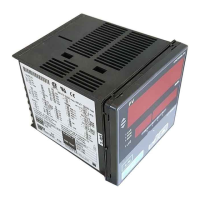6-8
<Toc> < 6. Function Block Diagram and Descriptions >
IM 05D01C02-41E 3rd Edition: May 31, 2006-00
■ Control Output
Control output (OUTPUT1) selects the output type among the current output, voltage pulse
output, and relay contact output signal. For heating/cooling control, the cooling-side
signals are output to OUTPUT2.
Preset output value is output when the operation is stopped by key operation or contact
input, which takes priority over the manual operation.
Each function can be set by the following parameters.
Setup Parameters
Function Parameter Main menu Submenu
Control output type selection OT1 UTMD OUT
Control output cycle time CT UTMD OUT
Cooling-side control output cycle time CTc UTMD OUT
Analog output 1 type AO1 UTMD OUT
Analog output 2 type (cooling-side) AO2 UTMD OUT
Operating Parameters
Function Parameter Main menu Submenu
Preset output n.PO LP1 n.PID
Output limiter n.OL, n.OH LP1 n.PID
Cooling-side preset output n.Oc LP1 n.PID
Note: Parameters n.PO, n.OL, n.OH , n.Oc (n=1 to 8), and submenu n.PID (n= 1 to 8) correspond to the target setpoint
number selected in the target setpoint number selection (SPN).
■ Contact Output
Alarm 1 is output via DO1 (contact output 1).
Alarm 2 is output via DO2 (contact output 2).
Alarm 3 is output via DO3 (contact output 3).
Alarm 4 is output via DO4 (contact output 4).
No function is assigned to DO5 (contact output 5) and DO6 (contact output 6).
FAIL is output via DO7 (contact output 7). ON in the normal condition and OFF in the FAIL
condition.
Setup Parameters
Function Parameter Main menu Submenu
Alarm 1 type AL1 LOOP1 ALM
Alarm 2 type AL2 LOOP1 ALM
Alarm 3 type AL3 LOOP1 ALM
Alarm 4 type AL4 LOOP1 ALM
Operating Parameters
Function Parameter Main menu Submenu
Alarm 1 setpoint n.A1 LP1 n.PID
Alarm 2 setpoint n.A2 LP1 n.PID
Alarm 3 setpoint n.A3 LP1 n.PID
Alarm 4 setpoint n.A4 LP1 n.PID
Note: Submenu n.PID (n= 1 to 8) corresponds to the target setpoint number selected in the target setpoint number selection
(SPN).

